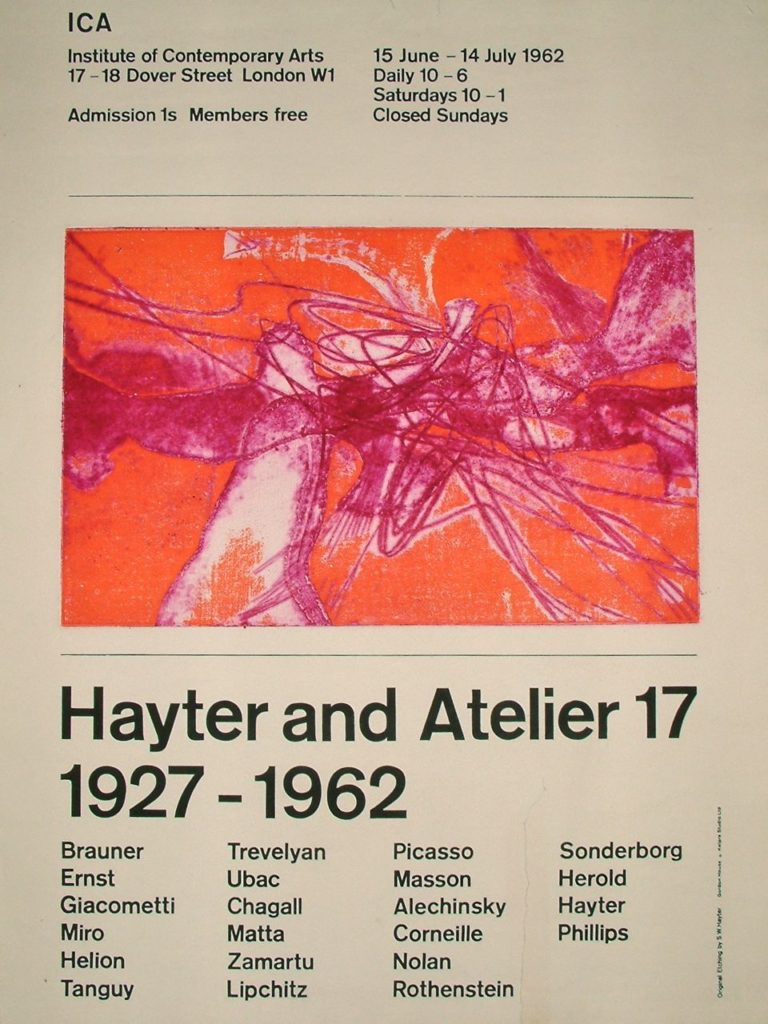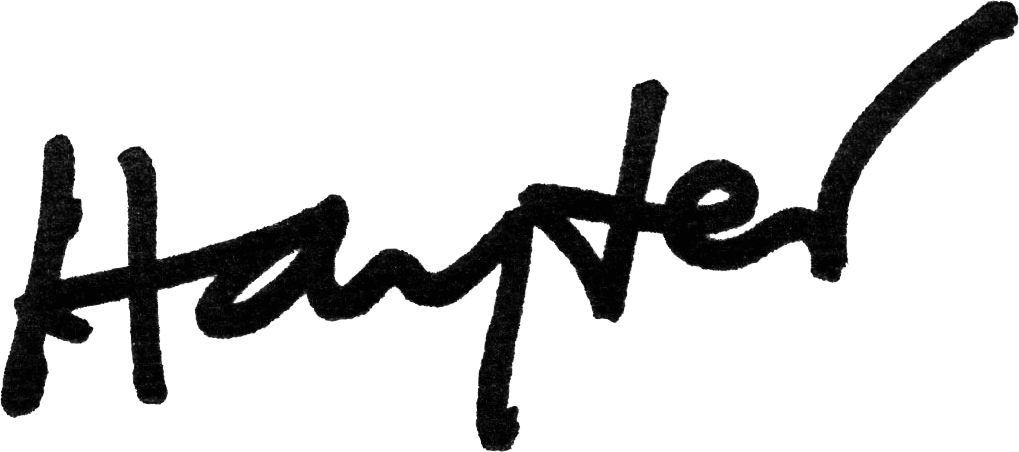Atelier 17

“Unlike the traditional workshops Atelier 17 has to do with an idea rather than with a fixed place, a permanent band of workers or artists, a uniform unvarying application of a known technique. How it came into existence, by pure accident if one believes in accidents; how it has changed and developed, moving to three different sites in Paris before being transferred to New York where it had three more homes, extensions of a sort to Philadelphia, Chicago, and San Francisco; its three different sites since its return to France in 1950; all this seems to me of far less interest to the general reader than a brief description of what it is now.
Although it has been mistaken for such by innocent people, the Atelier 17 is not a school, except in so far as the whole group and those who have worked in it, now in a dozen countries, could be said to constitute a ‘School’ in the historical sense. At any time, mature artists of world-wide reputation may be working in it alongside lesser-known artists of different ages and even some few art students often holding fellowships or ‘bourses’ from the French government or other foundations.”
S. W. Hayter, extract from chapter 8, About Prints, Oxford University Press, 1962.
A brief history of Atelier 17
Hayter arrived in Paris in 1926 and enrolled at the Academie Julian. He worked there for several months before meeting the engraver, Joseph Hecht. Hecht’s technique of engraving directly onto the plate pleased Hayter enormously. Intrigued by this technique a couple of women artists asked him if they could work and learn together and Hayter agreed and a press was bought and his studio at the Villa Chauvelot turned into a small workshop. In 1933 Hayter moved to 17, rue Campagne-Premiere and so began the Atelier 17 proper. The bigger space allowed for more working space and the workshop was now open for three days a week. Established professionals and beginners worked side by side. Hayter did not teach but he encouraged consistent experimentation and the transformation of the plate to an unforeseen result, ideally a leap into the unknown starting with no preconceived ideas. The excitement he generated with his innovative approach and ideas attracted many artists: Vieira da Silva, Arpad Scenes, Calder, Giacometti, Helion, David Smith,Kandinsky, Tanguy, Max Ernst, Wolfgang Paalen and many others. Picasso would drop by for technical advice.
The outbreak of World War 11 in 1939 forced the closure of Atelier 17 in Paris but when he arrived in the United States in 1940 Hayter was offered space at The New School for Social Research in New York and he set up shop there. Many of the exiled Surrealist artists started working with him including Dali, Masson, Calder, Tanguy also Chagall. Matta ,and Motherwell also and they were joined by a group of younger American artists many of whom had previously worked for the W.P.A., The Works Progress Administration. In 1945 the Atelier moved to a much larger space in East 8th Street where Jackson Pollock, Reuben Kadish, Fred Becker, Rothko, de Kooning, Baziotes, Louise Bourgeois, Louise Nevelson, Sue Fuller, Dorothy Dehner, Minna Citron also Wifredo Lam and Miro among others joined the group. Experimentation was still the order of the day and many inventive ways of adding soft-ground to the burin line by impressing all sorts of textiles and fabrics onto the plate were tried out with varying success. Also colour began to play a predominant role and constant attempts were tried to find a way of printing in simultaneous colour.
Hayter returned to Paris in 1950 and soon found a premise where he was able to re-establish Atelier 17. Over the subsequent years there were to be many other moves right up until his death in 1986. During the 1950s artists in the workshop were mainly European plus a steady stream from the U.S.A. who had studied with people from the New York Atelier 17 group now teaching art and printmaking at university faculties right across the U.S. During the 60s, 70s and 80s many printmakers arrived from Japan and Korea also India and South America working side by side, exchanging ideas and techniques plus the inevitable cultural exchange resulting in a lively, dynamic camaraderie.
The use of colour in printmaking gradually assumed more importance beginning in the 50s and 60s. This resulted from the long and patient search started in the 1930s by Hayter and Anthony Gross. They were convinced that Hercule Seghers had used simultaneous colour and they tried to unravel the process. During the 1940s many attempts were tried with varying results. Already Hayter’s 1947 print, Falling Figure, while using screens also employed inks of different viscosities but the results were not conclusive until the early 1950s when Krishna Reddy and Kaiko Mots slotted the final piece into the jigsaw. Since then simultaneous colour printing, more commonly named viscosity printing, is widely used and under the aegis of Hector Saunier, a master of the technique, continues to change and develop.
Hayter returned to Paris in 1950 and soon found a premise where he was able to re-establish Atelier 17. Over the subsequent years there were to be many other moves right up until his death in 1986. During the 1950s artists in the workshop were mainly European plus a steady stream from the U.S.A. who had studied with people from the New York Atelier 17 group now teaching art and printmaking at university faculties right across the U.S. During the 60s, 70s and 80s many printmakers arrived from Japan and Korea also India and South America working side by side, exchanging ideas and techniques plus the inevitable cultural exchange resulting in a lively, dynamic camaraderie.
The use of colour in printmaking gradually assumed more importance beginning in the 50s and 60s. This resulted from the long and patient search started in the 1930s by Hayter and Anthony Gross. They were convinced that Hercule Seghers had used simultaneous colour and they tried to unravel the process. During the 1940s many attempts were tried with varying results. Already Hayter’s 1947 print, Falling Figure, while using screens also employed inks of different viscosities but the results were not conclusive until the early 1950s when Krishna Reddy and Kaiko Mots slotted the final piece into the jigsaw. Since then simultaneous colour printing, more commonly named viscosity printing, is widely used and under the aegis of Hector Saunier, a master of the technique, continues to change and develop.
REFERENCE BOOKS ON ATELIER 17
About Prints, S.W.Hayter, Oxford University Press, 1962.
Atelier 17, Joann Moser, Elvehjem Art Center, Madison, Wisconsin, 1977.
New Ways of Gravure, S.W. Hayter, Watson-Guptill, 1981.
Atelier 17, 1927 Paris New York 1950, Galerie de Seine, Paris 1981.
The Renaissance of Gravure, Edited by P.M.S. Hacker, Oxford University Press, 1988.
Hayter et l’Atelier 17, Carla Esposito, Electa, 1990.
About Prints; the Legacy of S.W. Hayter and Atelier 17, Domenic Icon, Syracuse University Gallery, 2016.
The Women of Atelier 17, Christina Weyl, Yale University Press, 2019.
